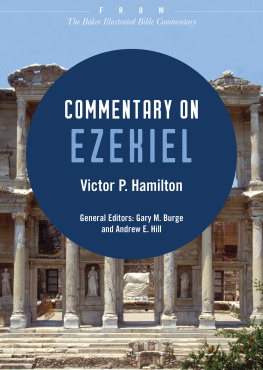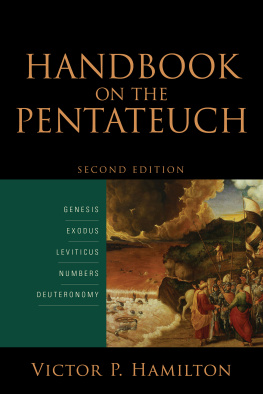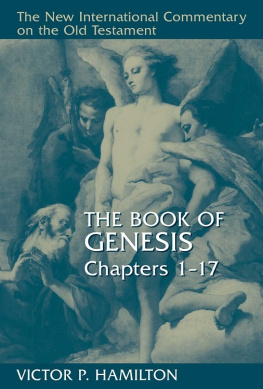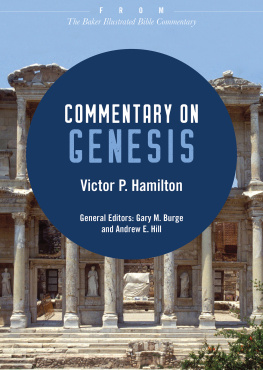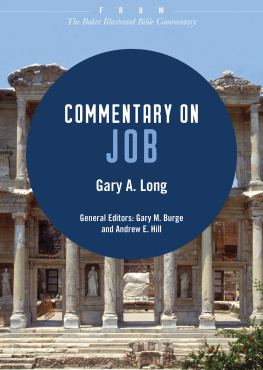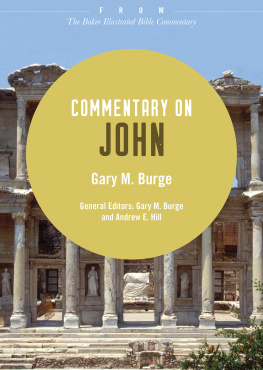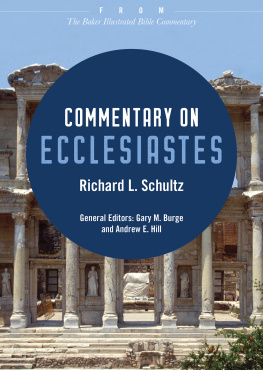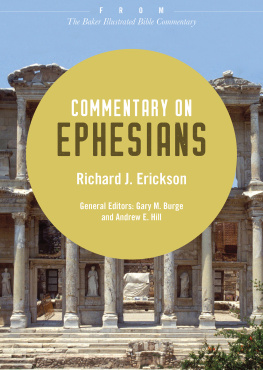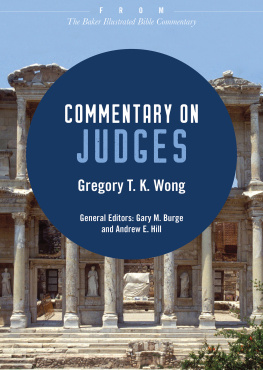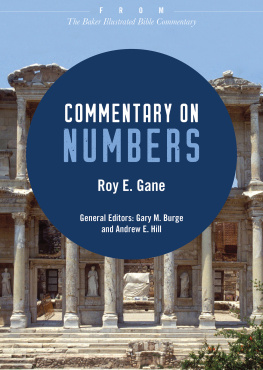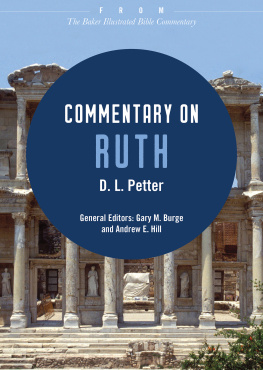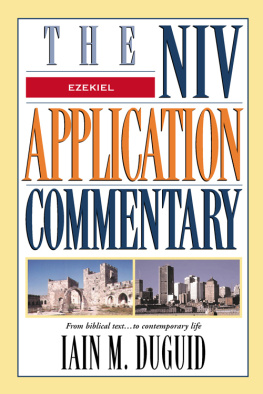Copyright Page
2012 by Baker Publishing Group
Published by Baker Books
a division of Baker Publishing Group
P.O. Box 6287, Grand Rapids, MI 49516-6287
www.bakerbooks.com
Ebook short created 2019
Previously published in The Baker Illustrated Bible Commentary edited by Gary M. Burge and Andrew E. Hill in 2012
All rights reserved. No part of this publication may be reproduced, stored in a retrieval system, or transmitted in any form or by any meansfor example, electronic, photocopy, recordingwithout the prior written permission of the publisher. The only exception is brief quotations in printed reviews.
Library of Congress Cataloging-in-Publication Data is on file at the Library of Congress, Washington, DC.
ISBN 978-1-4934-2460-3
Unless otherwise indicated, Scripture quotations are from the Holy Bible, New International Version. NIV. Copyright 1973, 1978, 1984, 2011 by Biblica, Inc. Used by permission of Zondervan. All rights reserved worldwide. www.zondervan.com. The NIV and New International Version are trademarks registered in the United States Patent and Trademark Office by Biblica, Inc.
Scripture quotations labeled ESV from The Holy Bible, English Standard Version (ESV), copyright 2001 by Crossway, a publishing ministry of Good News Publishers. Used by permission. All rights reserved. ESV Text Edition: 2007
Scripture quotations labeled NASB are from the New American Standard Bible, copyright 1960, 1962, 1963, 1968, 1971, 1972, 1973, 1975, 1977, 1995 by The Lockman Foundation. Used by permission. www.lockman.org
Scripture quotations labeled NIV 1984 are from the HOLY BIBLE, NEW INTERNATIONAL VERSION. NIV. Copyright 1973, 1978, 1984 by International Bible Society. Used by permission of Zondervan. All rights reserved.
Scripture quotations labeled NJPS are from the New Jewish Publication Society Version 1985 by The Jewish Publication Society. All rights reserved.
Scripture quotations labeled NKJV are from the New King James Version. Copyright 1982 by Thomas Nelson, Inc. Used by permission. All rights reserved.
Scripture quotations labeled NLT are from the Holy Bible , New Living Translation, copyright 1996, 2004, 2007 by Tyndale House. Used by permission of Tyndale House Publishers, Inc., Carol Stream, Illinois 60188. All rights reserved.
Scripture quotations labeled NRSV are from the New Revised Standard Version of the Bible, copyright 1989, by the Division of Christian Education of the National Council of the Churches of Christ in the United States of America. Used by permission. All rights reserved.
Scripture quotations labeled RSV are from the Revised Standard Version of the Bible, copyright 1952 [2nd edition, 1971] by the Division of Christian Education of the National Council of the Churches of Christ in the United States of America. Used by permission. All rights reserved.
Unless otherwise indicated, photos, illustrations, and maps are copyright Baker Photo Archive.
Contents
Abbreviations
| ANET | Ancient Near Eastern Texts Relating to the Old Testament . Edited by J. B. Pritchard. 3rd ed. Princeton, 1969 |
| BDAG | Bauer, W., F. W. Danker, W. F. Arndt, and F. W. Gingrich. Greek-English Lexicon of the New Testament and Other Early Christian Literature. 3rd ed. Chicago, 1999 |
| ca. | circa (about, approximately) |
| cf. | compare |
| chap(s). | chapter(s) |
| COS | The Context of Scripture . Edited by W. W. Hallo. 3 vols. Leiden, 1997 |
| e.g. | for example |
| ESV | English Standard Version |
| HALOT | Koehler, L., W. Baumgartner, and J. J. Stamm. The Hebrew and Aramaic Lexicon of the Old Testament. Translated and edited under the supervision of M. E. J. Richardson. 5 vols. Leiden, 19942000 |
| HCSB | Holman Christian Standard Bible |
| i.e. | that is |
| KJV | King James Version |
| NASB | New American Standard Bible |
| NEB | New English Bible |
| NET | New English Translation |
| NIV | New International Version (2011 edition) |
| NIV 1984 | New International Version (1984 edition) |
| NJB | New Jerusalem Bible |
| NJPS | The Tanakh: The Holy Scriptures: The New JPS Translation according to the Traditional Hebrew Text |
| NKJV | New King James Version |
| NLT | New Living Translation |
| NRSV | New Revised Standard Version |
| RSV | Revised Standard Version |
| TDOT | Theological Dictionary of the Old Testament . Edited by G. J. Botterweck and H. Ringgren. Translated by J. T. Willis, G. W. Bromiley, and D. E. Green. 8 vols. Grand Rapids, 1974 |
| TNIV | Todays New International Version |
Ezekiel
Victor P. Hamilton
Introduction
Ezekiel the Prophet
There are not many biographical details about Ezekiel in the book that bears his name. We know that the name of his father was Buzi (1:3). This is a strange name; the only Hebrew root we know of with which that name can be connected is shame. Buzi means literally my shame. But what parent would name a son my shame? Perhaps Buzi is related to another Semitic root that we cannot identify. Like Jeremiah (see Jer. 1:1), Ezekiel is a son of a priest but is called to be a prophet. Unlike Jeremiah, however, Ezekiels priestly heritage is prominent throughout his prophecy.

There are no such problems with Ezekiels own name. It means either El/God shall strengthen (a statement) or May El/God strengthen (a prayer). In the opening chapters God reveals to the prophet why his name is Ezekiel.
We may safely surmise that Ezekiel belonged to the aristocracy. It was the policy of the Babylonians, when they invaded and conquered a country, to exile only the upper levels of leadership. This would deprive subjugated peoples of effective leaders. Hegemony was maintained by silencing (and exiling as necessary) outspoken leaders of the resistance movement.
Ezekiel is unique among the prophets in that his entire ministry was conducted outside of Palestine. Every date in Ezekiel (a total of thirteen), outside of the problematical thirtieth year of 1:1, is reckoned from the year in which Judahs king Jehoiachin was carried into Babylonian captivity. The earliest date we find in Ezekiel is 593 BC (1:2; 3:16). The latest date in the prophecy is 571 BC (29:17). Thus, Ezekiels ministry spans approximately twenty-two years.
Ezekiel carries out his ministry while in captivity. He lives and preaches among his fellow exiles by the Kebar River. Ezekiel has his own parsonage (Go, shut yourself inside your house, 3:24, emphasis added). On numerous occasions the elders in exile come to talk with him or watch him at his house (8:1; 14:1; 20:1; 33:21), indicating that Ezekiel more than likely was a religious leader in Jerusalem before 597 BC and carried that stature with him into exile.
Ezekiel was married (24:1518), but we never hear of any children. In 4:14 he offers the protest from my youth until now I have never eaten anything found dead. That Ezekiel would use such a phrase indicates that he is no youngster. He is definitely older than Jeremiah.


